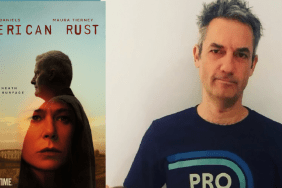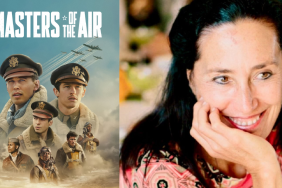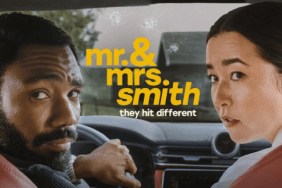
SHOCK sits down with DARLING composer Giona Ostinelli.
We have been raving about writer/director Mickey Keatings grinding, black and white psychological horror movie DARLING since we saw it last week (see our review here) and our admiration for the picture deepened once we sat down with Keating to discuss the films mechanics (read our interview with Keating here).
One of those key components that makes DARLING such a disarming picture to endure is the sound, a much-lauded aural backdrop that tears open the very fabric of the film and, very often, threatens to overtake it.
Indeed, DARLINGs score, an amalgam of neo-classical cues and industrial noise, is one of the most upsetting of soundtracks, further exploited by the fact Keating opts to push the volume up, making the music a character.
Often, its THE character.
That remarkable sound and fury is the work of prolific composer Giona Ostinelli and SHOCK had the honor of speaking with him to dissect his work and the use of it in the shadowy confines of Keatings fever dream.
SHOCK: The film owes something to many masters and there are hints of that in the music, from Jerry Goldsmith to a more industrial-based, early Lynch sound. It’s never easy to break down influence but can you discuss some of the aural inspiration you had when preparing DARLING?
OSTINELLI: Well, actually when I start working on a project, I never seek for inspiration from other film composers, simply because then I dont feel like Im creating anything new but rather trying to imitate my influences. For DARLING in particular, the inspiration came from the picture itself and the endless possibilities my chosen instrumentation presented. Theres barely any dialogue throughout the whole film, so the music had to play a major role by basically being another character in the film that is always present. It is a rare opportunity in todays film industry as well as a major challenge since the score has to be incredibly focused guiding the audience through the film with confidence. Early on in the process Mickey and I spoke at length about the sound of DARLING. We discussed using the waterphone as one of the main instruments, so I went ahead and started experimenting by recording several of those and creating a variety of eerie textures. We also talked about portraying the classic and elegant side of Darling. That is where the idea of incorporating piano and strings came from, however I couldnt just use a regular piano throughout, there had to be some sort of twist. So later on in the picture as Darlings visions slowly become more and more maddening the piano sound starts transforming and becomes reversed and distorted.
SHOCK: The movie’s strength is in creating horror and unease in often very innocuous action…your sounds are key here. Were you there from the ground up or did you come on board after Keating had cut the picture?
OSTINELLI: With DARLING being our third collaboration, Mickey and I have developed a certain rhythm, dynamics. Mickey always sends me the script in advance and we try to schedule our initial conversation before he starts shooting. I strongly believe with music being such an important element in a film it is always beneficial to start discussing it as early as possible. While Mickey was shooting and editing, whenever I had time in between my other films, I would experiment with various instruments and sounds. In fact, I have quite a lot of material that I wrote in advance that no one would ever hear, but I find plenty of advantages in doing that. Having scored over 28 features in my career and written music for multiple television series for major networks, Im used to writing very fast; however spending time with the script and developing ideas before I have an actual cut to work with allows me to start building and sculpting the soundscape for the film from early on. Obviously, its not the way to approach every project, especially the ones on a very tight schedule, however its definitely the way to go with Mickeys films, especially in the case of DARLING where the score and the overall sound is basically a signature trademark of the film. Once the cut is ready for me, it is time to utilize these ideas developed beforehand and start sculpting them to picture and letting them evolve. Obviously, you cant imagine that all those ideas will work perfectly to the picture, as they most likely wont. However they will serve as a strong foundation from which you can start building the rest of the score.

SHOCK: As this is a “female” picture, did gender affect the nature of the music?
OSTINELLI: Absolutely. The instrument that represents the main character is piano, and this choice was heavily influenced by the fact that the main character is a woman. Moreover, her voice was given to her by acclaimed concert pianist and composer Sonya Belousova, the star of the Player Piano series. On top of recording an ensemble or orchestra the score requires, I often collaborate with extraordinary soloists who bring their own unique character into music. As Darling becomes more deranged and her visions slowly start driving her insane, Sonyas elegant piano touch slowly transforms as well starts being processed through a very specific type of reverb that I designed to achieve a reversed effect. In fact, the score, and especially instrumentation, always has to evolve together with the character throughout the film. For example, in the scene at the very beginning when Darling is exploring the house, theres a slow waltzy type of cue representing a dance, a certain mysterious connection between the main character and the house. Or, one of the most climaxing scenes in the film is the pre-stabbing sequence that features Sonyas performance of 3 preludes opus 11 by Scriabin. On top of recording a chamber ensemble, another instrument that is quite featured and heavily distorted in the score is cello, recorded by renowned soloist and recording artist Eru Matsumoto.
SHOCK: There’s percussion, strings, piano…seemingly all organic instruments. Did you employ any electronic instrumentation?
OSTINELLI: Yes, acoustic instruments are only 50% of the score. Around three quarters into the film, the score becomes completely industrial, with distorted metal percussion, pulsating moog bass, electric guitar and a variety of custom sound elements. Whenever I have a chance, I like spending time with my synthesizers building unique sounds that will be a part of a films soundscape. I almost never re-use these sounds for other films or TV episodes, as I like creating a particular sounding world for every project in order to enhance the genre and create a truly distinctive sound experience for the audience. Darling presented a wonderful opportunity to experiment writing a score as a combination of classical, noir and sound design elements. I was able to achieve a particular sound by creating a hallucinatory soundscape, which features a heaving distorted ondes martenot combined with various layers of piano going through a reversed piano effect. Ondes martenot, a rare vintage instrument, was recorded in France and later on amplified with Marshall Amps, just like you would with a guitar, as well as enhanced with delay and heavy distortion. In fact, the howling sound that you hear at the very beginning and further on in the film is that transformed ondes martenot. And whats interesting about this sound is that the instrument, being vintage by its origin, sort of transforms with its amplification and through other effects and gets modernized. On top of these hypnotic intricate sonorities I occasionally introduced a distant solo trumpet, which added a disturbing noir element that worked perfectly with the black-and-white images. I always felt that Mickeys black & white depiction of New York was asking for a slight jazzy touch. Thats where this idea came from. One of Mickeys signature elements is disturbing flashing images on screen combined together with heavy sound design. For the score I recorded the sound of electricity, and I literally mean electricity. My team and I went near a transmission tower and we recorded the sound of electricity there. Then I took the recording to my studio, enhanced and distorted it and transformed it into a disturbing sound, which shocks the audience every time those flashes appear on screen.

SHOCK: Would you consider this an experimental score?
OSTINELLI: Yes I would. Every creative score I think is an experimental score. I believe being a film composer is like being an explorer. You have to discover new ways of using traditional instruments, find interesting solutions and create new unique sonorities. And the best part is that we live in a time when, thanks to technology, everything becomes possible. I mentioned before that I recorded amazing Eru Matsumoto on cello. Eru was able to achieve this really disturbing sound out of her cello and I had to find a way to use it in creatively rather than simply as a cello sound. She created this high-pitched, distorted, screechy sonority that was literally giving me goose bumps. So I took the recording, sped it up, enhanced it with various effects and made it sound even more disturbing like it was coming from another world. And that become the main sound for the scene when Darling finds the crucifix in the wardrobe.
SHOCK: Keating turns your music up LOUD in the mix, till it often overtakes key scenes. Are you happy with what he did with the sound editing?
OSTINELLI: Mickey is one of the directors who perfectly understand the power of a dynamic mix in a film. Our sound mixer Shawn Duffy is masterfully able to create a clean and balanced mix between the score, dialogue and sound effects. Mickey tends to have his final mix sound quite unpredictable. By doing that he provides a wonderful opportunity for both Shawn and I to be 100% creative in our choices, and at the same time keeps the audience on the edge throughout. A great film in not only a visual art form but includes many elements ranging from cinematography, acting, editing to score, sound design, etc. As a filmmaker you have to be able to utilize all those elements to the most of your advantage to create the best possible experience. Thats why working with Mickey is always a thrilling journey as he is willing to go all the way and push all the co-existing elements to their limits.
SHOCK: While watching films, as a fan, when was the first time you “noticed” score?
OSTINELLI: There were three films that I saw as kid that made me fall in love with music for films. I started playing drums when I was 5, piano at the age of 9. Around the same time I remember trying to recreate scenes from famous films with my friends or on my own with Lego. And so I always knew that I wanted to combine both of my passions, music and film. Around the age of 7-8 I watched for the first time BACK TO THE FUTURE, ROMANCING THE STONE and INDIANA JONES AND THE LAST CRUSADE, and these three films made me realize that I wanted to focus on writing music for films.

SHOCK: What was the last film you saw where you were truly impressed by the music. And have you ever felt envious about certain scores? Like, you wished YOU had done that?
OSTINELLI: The latest film that I watched where I was totally wowed by the score was THE MAN FROM U.N.C.L.E. What Daniel Pemberton did with the score is simply awesome. The whole production, themes and instrumentation were so well done
For more on Ostinelli, visit his official website here.









